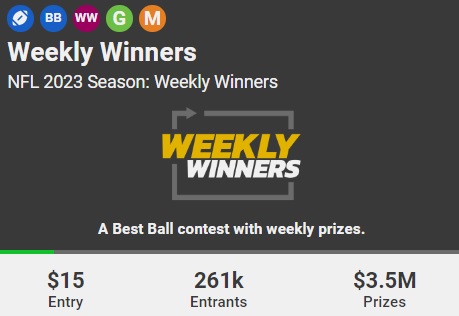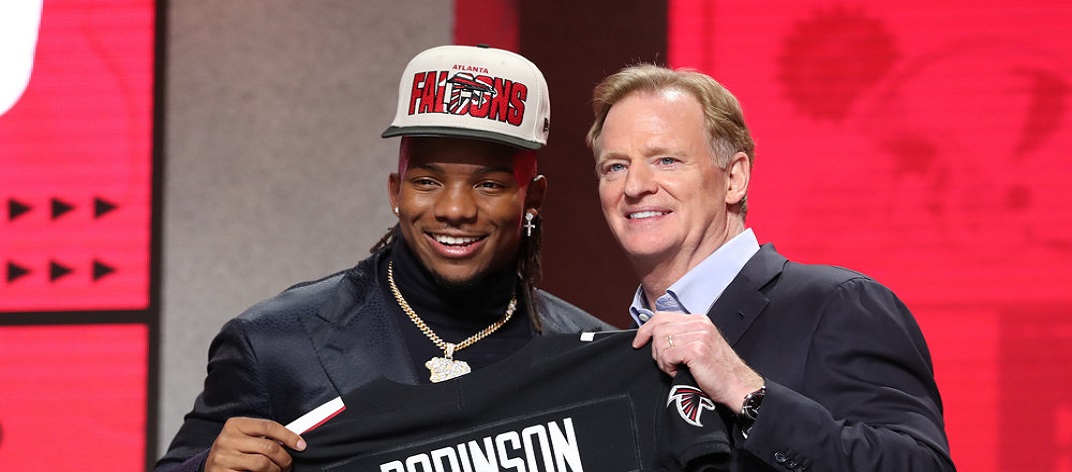Underdog’s Weekly Winners Best Ball Contest Primer

Underdog has released a new Best Ball tournament style called Weekly Winners, which blends Best Ball concepts with weekly DFS tournaments. This new tournament format is very unique and could create a lot of edges as people might not approach it in the correct way. There are a number of interesting strategy concepts that could be implemented in this format, but before digging deeper it’s important to look at the distinct differences between traditional Best Ball, traditional DFS, and this new tournament. In addition, I will focus on how this format impacts each position.
Basic Contest Details:
-$3.5 million in total prizes
-$205,000 paid out each week
-weeks 1-17
-Total entries- 261,000
-Total in the money each week- 7,315
Similarities to Best Ball:
Like the BBMIV or Underdog’s other regular tournaments, you are part of a 12-person draft, and you select 18 players, building out a roster that will start 1 QB, 2 RBs, 3 WRs, 1 TE, and 1 Flex. There is no setting the line-up beyond the initial draft. The best eligible players on your team are automatically placed in those starting line-up spots. The scoring rules are also the same to other Underdog contests.
Differences to Best Ball:
In regular best ball tournaments, you directly compete with the 12-person group you draft with. Typically you need to finish in the top 2 of those after 14 cumulative weeks of the regular season. you then are placed in playoff groups for weeks 15 and 16, before the finals during week 17. In this format, after you draft with your 12-person group, there is no other direct competition. Every week you compete against every other team drafted in the tournament. There is no worrying about advancing because each week is its own singular contest. You are entering the 18-player line-up you draft essentially into 17 different contests.
Similarities to DFS Tournaments:
Given that each week is a unique tournament, it is comparable to traditional large-field DFS tournaments on DraftKings and Fanduel (particularly Fanduel given the scoring system). You are competing with every other entry’s best line-up for that given week and there is zero cumulative scoring considered. Stacks and correlation can play a bigger factor, for the weeks that you are focused on.
Differences to DFS Tournaments:
The biggest difference is that instead of roughly a 20% cash rate, only about 3% of line-ups will cash in a given week. To make up for that, you are entering the same 18-person line-up for the other 16 weeks of the season. While it’s unlikely that you will be competitive all 17 weeks, you should look to build a line-up that is competitive for 14 or 15 weeks. So while each week you have a lower shot to finish in the cash, you have far more chances for the same price point.
Unlike DFS where you are only selecting your starting line-up, you have additional outs on your roster. This can make more line-ups live as it could end up being some uncorrelated player that ends up being the key to taking a really strong line-up to the top of the leaderboard.
What is also different is that every game on the slate for that week is included. In recent years the biggest DFS tournaments are based solely on 1 pm and 4 pm games. Every Thursday, Sunday, and Monday night game, plus every other game in a different time window (international games, Thanksgiving, Saturday games) aren’t included. This leads to a number of weeks of 10-12 game main slates, even in weeks where there aren’t a lot of byes.
The other biggest difference is in this draft format, there really isn’t any way to have ownership leverage for any of the top 150ish + players. Every one of them will be drafted in every single 12-person draft. In a regular DFS tournament, you might find situations where a good player’s ownership is squeezed and they are only owned in less than 5% of line-ups that week. On the flip side there won’t be any players owned 25-30%. Instead, every player will be drafted 21,750 times or 8.3%. Given that only 7,315 even cash in a week, just having a top player at a position doesn’t guarantee that you finish in the money.
Between the deeper rosters, all games on the slate, and steady ownership, we should expect scores to be higher in Weekly Winners than in a similar size field DFS tournament for the same week.
How positions should be valued in this format:
Quarterbacks:
Top-tier QBs should be drafted higher in this format if you are going to win the week you are likely to need the top-scoring QB or the 2nd or 3rd guy if they are only behind them by a couple of points. Remember there are over 21K line-ups with that high-scoring QB, so can’t expect to overcome all of them if you are conceding many points. To be a top-scoring QB, you are generally going to need 30 or more points, high 20’s are a bare minimum. Getting under 25 fantasy points from your QB will make it nearly impossible to even cash most weeks.
This massively favors the top-end QBs who should have multiple viable 30-point+ games. The top tier should definitely include Patrick Mahomes, Josh Allen, Jalen Hurts, Lamar Jackson, Justin Herbert, and Joe Burrow. Justin Fields and Trevor Lawrence could potentially make the case as well. After that though it does thin out some. QBs with more spike week potential like Fields, Daniel Jones, and Anthony Richardson do have the upside for the real 35-40 point games that could set you apart. Now their consistency is less crucial in this format, but realize with their volatility you might only be live for 2-4 weeks with their style of play.
Generally, I think 2 QBs is typically the way to go in this format, as it’s likely most of the bottom 3rd of QBs are just bye-week fillers or guys who could raise your floor by a couple of points on down weeks. That can have value when you are trying to get enough points in the 14-week regular season to advance to the playoffs, but it has little value here.
Running backs:
Oddly the running back position has been a bit devalued on Underdog, despite the scoring system favoring running backs. Early on this continues to be the case for Weekly Winners, but this seems like a major mistake. Most weeks it’s likely the majority of the top 100 teams (and honestly teams that just cash) will utilize an RB in the flex position. That is how you should be building your roster with that mindset. At the very least you will need 2 very good running back scores. This makes zero RB builds, extremely tough to be successful. Hero, Double-Hero, and even Hyper-Fragile are likely to pay off more.
Running backs simply score more total points and produce more spike weeks than receivers. Last season RBs had both more 30-point games and 20-point games than receivers, despite the fact that NFL teams basically start 3 WRs vs 1 RB. Things can change in a given year, but trying to identify elite backs will pay off for you more than spending too much at the receiver position.
The types of backs you should target are also different in this format. Feature backs with either a strong TD role, or both the rushing and receiving role should be the primary options. Backs from split backfields are going to have a tougher time consistently producing 20-30+ point games. It’s not to say you avoid those types of backs entirely, but you should bake in risk to how you evaluate them. When you do take shots on them, target the project TD scorer. They might not have as strong of a floor, but if they have a 2 or 3-TD game you could have a massive value.
Wide Receivers:
In this format, you should build that 3 WRs will be in your line-up, and 3 RBs. This is going to be the best chance to have the combo of players hitting 20-30 point games. While some of this will simply start by targeting a couple of receivers in the first 5 rounds, and then just looking for high-upside spike week guys to balance them out. Solid consistent receivers who are strong 10-15 point players just won’t really cut in this format. More volatile guys with either downfield ability or potential red zone targets are guys you should target. If you want to be near the top of the leaderboard you are likely going to need a player or two with multiple TDs that week.
Receivers are still definitely important in this format, but they are being overdrafted so don’t feel the need to follow the crowd and weaken your total chances of success. Don’t spend too much draft capital on a position, that doesn’t have the same amount of upside. It’s also generally easier to find a spike week capable receiver later in the draft than a RB with a role that could be considered a featured role.
Tight Ends:
This format significantly favors Travis Kelce, but should push down the rest of the top TE tier. Kelce is the one TE who consistently has put up 15, 20, and even 30-point fantasy games over the years. He was top 3 in TE fantasy points for 9 weeks last season, and at any point can pop off for 30+ just burying the rest of the tight ends. While Mark Andrews, George Kittle and T.J. Hockenson have shown decent spike week potential, they aren’t as consistent and have more target competition. This will likely lead them to have far more weeks under 10 points, taking you out of the mix of winning the position. In this format every tight end not named Kelce should probably fall by at least a round in terms of ADP. Drafting 3 or 4 late TEs could produce similar 20+ point game numbers, and will cost a lot less in draft capital. The one exception to this is if you are stacking them with your QB, but even then it might not be fully worth the investment.
The value of “Bully TE” builds definitely takes a hit, as when you are trying to compete for a 3% outcome each week (and really a top 0.01%), the chance that 2 TEs will be the nuts is extremely unlikely. While having 2 top TEs can give you 2 decent chances of a top score, you are weakening RB or WR which are higher-scoring positions. There is also no value for using 2 TEs to try to advance from the regular season.
If you are new to Underdog Fantasy, sign up here and be sure to use code FANSPEAK for 100% deposit match up to $100!


